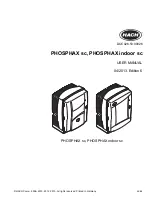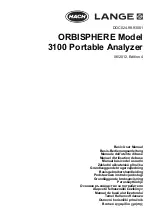
IEEE-488 Reference
3-7
3.7
Front panel aspects of IEEE-488
operation
The following paragraphs discuss aspects of the front panel
that are part of IEEE-488 operation, including messages, sta-
tus indicators, and the LOCAL key.
3.7.1 Error and status messages
Table 2-4 summarizes the error and status messages associ-
ated with remote programming using SCPI and Common
Commands. Additional information on errors associated
with RS-232 operation is provided in paragraph 3.25.
3.7.2 IEEE-488 status indicators
The REM (remote), TALK (talk), LSTN (listen), and SRQ
(service request) annunciators show the present IEEE-488
status of the instrument. Each of these indicators is briefly
described below.
REM —
This indicator shows when the instrument is in the
remote state. Note that REM does not necessarily indicate
the state of the REN line, as the instrument must be ad-
dressed to listen with REN true before the REM indicator
turns on. When the instrument is in remote, all front panel
keys except for the LOCAL key are locked out. When REM
is turned off, the instrument is in the local state, and front
panel operation is restored.
TALK —
This indicator is on when the instrument is in the
talker active state. The unit is placed in this state by address-
ing it to talk with the correct MTA (My Talk Address) com-
mand. TALK is off when the unit is in the talker idle state.
The instrument is placed in the talker idle state by sending it
an UNT (Untalk) command, addressing it to listen, or with
the IFC (Interface Clear) command.
LSTN —
This indicator is on when the Model 6517A is in
the listener active state, which is activated by addressing the
instrument to listen with the correct MLA (My Listen Ad-
dress) command. Listen is off when the unit is in the listener
idle state. The unit can be placed in the listener idle state by
sending UNL (Unlisten), addressing it to talk, or by sending
IFC (Interface Clear) over the bus.
SRQ —
The instrument can be programmed to generate a
service request (SRQ) when one or more errors or conditions
occur. When this indicator is on, a service request has been
generated. This indicator will stay on until the serial poll byte
is read or all the conditions which caused SRQ have ceased
to exist. See paragraph 3.8.6 for details.
3.7.3 LOCAL key
The LOCAL key cancels the remote state and restores local
operation of the instrument.
Pressing LOCAL also turns off the REM indicator and re-
turns the display to normal if a user defined message was dis-
played.
Note that the LOCAL key is also inoperative if the LLO (Lo-
cal Lockout) command is in effect.
3.8
Status structure
The status structure for the Model 6517A is summarized in
Figure 3-5. Instrument events, such as errors, are monitored
and manipulated by seven status register sets. Notice that
these seven status register sets feed directly or indirectly into
the Status Byte Register. More detailed illustrations of these
register sets are provided by Figures 3-6 through 3-12.
Содержание 6517A
Страница 1: ...Model 6517A Electrometer User s Manual A G R E A T E R M E A S U R E O F C O N F I D E N C E...
Страница 310: ...A Specifications...
Страница 311: ...A Specifications...
















































